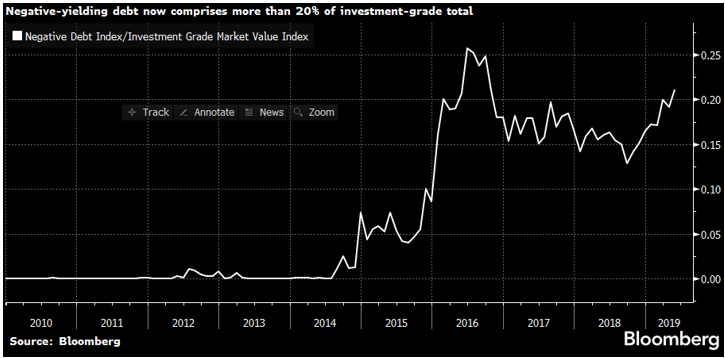Negative interest rates … the abnormal becomes ‘normal’
Hedonic adaptation is a psychology term that describes the human tendency of reverting to a relatively stable or ‘normal’ state following either positive or negative life changes … this is why the novelty value of your shiny new iPhone wears off quickly.
Applying this concept generally, we can adjust to things that were once considered abnormal and view them as now being normal.
An example in financial markets is the prevalence of negative yielding bonds. Once thought to be an outlier phenomenon limited to Japan, the chart below shows the growth of negative yield bonds globally.
By the end of May an astounding 21% of all investment grade bonds globally had a negative yield.

According to Bloomberg data, last week the total amount of negative yielding bonds globally reached a new record level of USD13 trillion.
European bonds led the way as 10 year German government bonds broke their own record, reaching a yield of negative 0.33%.
In Denmark, which has had negative interest rates longer than any other country, residential mortgage bond rates out to 5 years have been negative since May, with that dynamic now starting to spread across the EU.
Last week, the Financial Times reported that yields on 5 year German mortgage backed bonds went negative for the first time, reaching a yield of -0.2%, and went on to note;
“That means investors are essentially paying for the privilege of lending money into Europe’s largest property sector. Economic logic — or gravity — has been turned on its head.”
Financial Times – 28 Jun 2019
Startlingly, it’s not just government bonds with minimal credit risk that are at negative yields but also bonds issued by companies (i.e. corporate bonds), where there is more risk of the bond issuer failing to repay the bond, imposing large losses on bondholders.
For example, companies like luxury goods retailer Louis Vuitton and pharmaceuticals giant Sanofi have issued bonds this year at negative yields.
Admittedly, both are large companies with solid balance sheets, so the risk of default is currently low but in an economic downturn or if company specific negative catalysts occur that risk could increase markedly.
This is why any rational risk pricing framework would require corporate bonds to offer positive yields to provide a buffer against these types of uncertainties.
But as a ‘reach for yield at any cost’ mentality has taken hold, sensible behaviour has been forgotten.
As we noted in a previous article, this is the kind of behaviour you might see towards the end of a big night out. Seems like a good idea at the time but the next morning … not so much.
Meanwhile, as the risk party continues, collapsing government bond yields are forcing significant spill over demand into corporate bonds and other securities further along the credit risk spectrum … irrespective of whether their additional yields adequately compensate for the credit and liquidity risks that investors are being exposed to.
This comment from strategists at BofA Merrill Lynch (somewhat depressingly) sums up the current situation;
“Following plunging global yields 10-year government bonds are now yielding -50bps in Switzerland, -25bps in the Eurozone, -12bps in Japan and +207bps in the US.
How are you going to earn at least something in fixed income? Buy corporate bonds.”
– BofA Merrill Lynch Credit Market Strategist, 10th June 2019
If your approach to fixed income investing is to simply accumulate bonds for yield, then sadly they’re probably right … buying corporate bonds is the least bad option currently available.
However, as we continually tell our investors, there’s more to fixed income than just buying bonds. Even when yields are very low, there are other ways to generate attractive risk-adjusted returns from a defensive fixed income portfolio, without resorting to adding more credit or duration risk.

